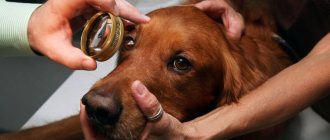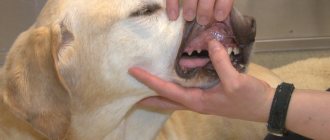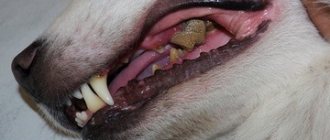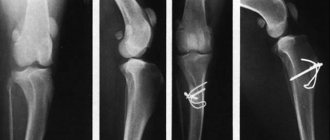What is an ear mite
What does a parasite look like? This is a very small insect, not reaching one millimeter, with a greyish-white translucent body, with a gnawing mouthpart. It gnaws through the skin and makes passages under it, laying eggs in them.
Ear mites under a microscope
The wounds become inflamed and fester. The larvae, feeding on the products of suppuration and lymphatic fluid, reach sexual maturity after 3-4 weeks, and then also lay eggs. In a short period of time, an ear mite can damage not only the skin of a dog’s ear, but also the eardrum, and further penetrate into the inner ear and brain.
The disease develops unnoticed - when the animal begins to show signs of the presence of a tick, then, as a rule, a significant part of the ear is affected. In addition, it was noted that the activity of the insect is subject to some cyclicity: a period of activity and bright symptoms is replaced by more or less calm intervals. This may be due to the cyclical development of the parasite. When pathology takes on threatening forms, there are no periods of rest.
How can a dog become infected with ear mites?
Ear mites can be transmitted from one animal to another, regardless of what stage of development it is at. During itching, the dog intensively scratches its ears, contributing to the spread of the parasite throughout the entire surface of the body. That is, the tick and its transitional forms can be located anywhere the pet is.
A healthy animal can “catch” ear mites in the following ways:
- upon contact (even fleeting) with a carrier animal;
- through a grooming item used by an infected dog;
- from a person who had contact with an affected representative;
- through fleas (they can carry tick larvae);
- from the mother (in puppyhood).
Symptoms of ear mites
You can suspect ear mites in a dog if you find a dirty brown mass in the external auditory canal. It is formed from skin scales, particles of the outer integument of shed parasites, and the secretion of the ear glands. All this is mixed with purulent discharge from damaged areas of the epidermis and mite excrement, and leads to severe skin irritation and an inflammatory process.
Other ear mite symptoms:
- hyperemia of the skin of the ear canal;
- severe itching;
- swelling of the ear folds.
The dog is nervous, shakes its head, and often itches. When scratching or shaking the ears, particles of accumulated mass may fly out of the external auditory canal.
Complications of the disease
If left untreated, otodectosis in dogs leads to inflammation of the inner ear. In this case, pain appears, the animal shakes its head and whines at the same time, since sudden movements only intensify the pain. What is especially dangerous is that at this stage the treatment no longer has any effect. The fact is that the ear mite immediately dies after laying eggs. As a result, visual inspection fails to determine its presence.
After some time, symptoms of otitis and otodectosis appear, since the mature eggs have turned into full-fledged parasites that feed on the pet’s blood. That is, even if you have undergone treatment, an exacerbation may begin after a while.
As a result of the spread of the process, ear mites in dogs can lead to pathologies such as perforation of the eardrum, labyrinthitis, meningitis and others. They, in turn, often lead to death if left untreated.
The presence of complications can be determined by carefully monitoring your pet. There are often photographs of dogs in which, after treatment for ear scabies, a characteristic position of the animal’s head towards the affected ear is noted. There may also be retraction of the eyeball. These symptoms are a reason to visit a veterinarian to examine the dog and prescribe effective treatment.
Diagnostics
Diagnosing ear mites in dogs is not difficult: during the examination, the veterinarian will take material from the ear and look at it under a microscope. In the chronic form, bacterial seeding of the contents of the ear canal may be required to determine the sensitivity of the insect to drugs and to select the optimal drug. In advanced cases, a specialist may prescribe an X-ray examination or computed tomography to identify the condition of the inner ear and membranes of the brain. Additional diagnostic procedures include: bacterial analysis, scrapings, and allergy tests.
How does otodectosis infection occur?
Ear mange is one of the most common problems in animals. Ear mites are scary because they are easily transmitted through contact of a sick individual with a healthy one. If at least one furry in the house is sick, the likelihood of the rest getting sick is very high. And it doesn’t matter who is sick: a dog or a cat. Any tailed inhabitant of the house can become infected.
It also doesn't matter whether it's winter or summer. Ear mites in dogs can appear at any time of the year. After all, the conditions for staying in the animal’s ears are very suitable for it: warmth, and “food” is always in abundance.
Young animals under 1 year of age and dogs with weak immune systems are most susceptible to infection with otodecosis. If the danger is not detected in time, the parasite from the ear can gradually move throughout the body: first to the head, and then to the back, stomach, tail and paws.
Is it possible to identify ear mites yourself at home?
There are situations when it is not possible to conduct a microscopic examination of a dog in a clinic. Before treating your pet for otodectosis, you can independently identify the parasite at home. To do this you will need a cotton swab, a piece of dark paper and a magnifying glass. Taking a small amount of plaque from your pet’s external auditory canal with a stick, you need to apply it to paper. If the disease is present, under a magnifying glass you can see moving ticks of a light gray hue.
Important: at the initial stages of pathology development, the population may be small. Therefore, the likelihood that the collected material will contain insects is reduced.
Typical symptoms of ear mites in dogs
Ear scabies manifests itself as a sharp, systematic itching in the area of the auricle and ear canal. Because of this, the dog shakes its ears and head vigorously and frequently, and scratches its ears with its paws. Sometimes the disease quickly progresses to the stage of purulent otitis media.
On a note
Although ear scabies and purulent otitis are often identified, it is relatively easy to distinguish them even at home (this can be important for choosing the direction of treatment, since before starting it, it is necessary to understand what exactly caused the disease). Classic otitis is not preceded by prolonged itching; animals do not scratch their ears, as they experience severe aching pain in the ear canal. The nature of the discharge from the dog’s ears is also significantly different: when infected with ear mites, a dark brown viscous mass is present, it smells bad, crusts form, while with otitis media, the discharge is usually relatively liquid and is a derivative of suppuration.
If the disease is not detected in the initial stages, inflammation can lead to perforation of the eardrum. This will be followed by inflammation of the inner ear, followed by inflammation of the upper membranes of the brain.
The following are the main symptoms that appear when a dog is infected with ear mites:
- animals shake their heads sharply and often scratch their ears;
- whine;
- pathological changes in head position are observed (dogs tilt their heads, turning the sore ear down);
- the pet becomes irritable;
- sleep is disturbed, the dog does not eat well;
- puppies do not gain weight;
- Sometimes there is also an increase in body temperature.
This is interesting
The disease often occurs in a chronic form. Itching may occur sporadically due to the temporary activity of mites. Sometimes the symptoms of otodectosis in a dog are very mild, but it can infect other dogs with which it comes into contact.
As noted above, the disease is often complicated by accompanying microflora. At the same time, multiplying bacteria can create conditions unfavorable for otodect mites, and after some time the population of parasites in the dog’s ear canals may even decrease significantly because of this. When treating such cases, much attention is paid to the destruction of foci of staphylococcal infection.
It is also useful to read: How forest ticks reproduce
When treating otodectosis in dogs, you should not rely only on your own strength or seriously rely only on traditional methods of treatment - it is important to consult a specialist in time. The final diagnosis is made after laboratory examination of discharge from the dog's ear (mites are detected in it using a microscope).
It is important to understand that due to the small size of the parasites and their large number, it will not be possible to simply remove or somehow wash the ticks from the dog’s ear canal. In this situation, only drug treatment is effective, which should be started after consultation with a veterinarian.
How to prepare a dog's ear for treatment
Before instilling ear mite drops, you need to clear your pet's ears of any accumulated mass. If the dog resists (not all animals tolerate this procedure stoically, especially if they experience pain), it is better to carry out the procedure together. For small sizes, you can throw a blanket over it or wrap it in a towel. If the pet is large, you should use a muzzle.
During the cleaning process, you must adhere to the following recommendations.
- You need to use sticks, not cotton swabs or disks, as there is a risk of pushing the accumulated mass deeper into the ear canal.
- You should start cleaning from areas located close to the edges of the ear, gradually moving deeper.
- The movements of the wand should be outward.
- If the masses are dry, you can wet the cotton end with peroxide or chlorhexidine. You can't put them in your ear.
- It is advisable to use lotions specifically designed for this purpose to clean your ears.
- If your dog has long hair growing on his ears, it will need to be cut off during treatment.
Treatment algorithm for ear mites in dogs
When treating dogs for ear mites, various acaricides are used, and the first thing you should pay attention to is the variety of drug forms.
Thus, there are four main types of anti-tick medications:
- sprays;
- drops;
- ointments;
- powders.
It is also useful to read: How forest ticks attack humans
Most of them are quite suitable for use at home, but before using this or that drug, you should definitely consult a veterinarian. Firstly, only a specialist can make a final diagnosis, and secondly, the choice of drug and concentrations will largely depend on the intensity of the infection (how advanced the otodectosis is). Thirdly, it is often also necessary to relieve concomitant symptoms of the disease caused by its complications.
Despite the significant difference in approaches to treating ear mites, there is a certain algorithm of action that should be followed.
First, you need to limit the contact of a sick animal with healthy ones. It is helpful to wash your dog regularly and thoroughly, but make sure that water does not get into the ears. Before administering medications, the ear canal must be cleared of secretions and crusts. To do this, you need to pour a saline solution into the ear (either a chlorhexidine solution or a special lotion for cleansing the ears), wait about 5 minutes, and then very carefully massage and clean the softened mass with a cotton swab. Only after this can you begin to administer the drug.
An example of a good lotion for cleaning the ears of cats and dogs is Otifri:
On a note
It should be taken into account that in a dog suffering from otodectosis, massage in the area of the auricle can cause significant pain, so this procedure should be carried out as carefully as possible, without excessive pressure.
Drops are introduced into the ear canal with a pipette, after which the base of the ear is again subjected to a light massage. If ointment is applied, this is done using a tampon. The powders are carefully poured into the auricle and distributed with a cotton swab (without going deep into the ear canal). Also very convenient are sprays that are sprayed into the ear and onto the animal’s fur according to the instructions.
Drops and sprays are considered the most effective anti-ear mite medications that give quick results, since they contain a high concentration of active substances and effectively penetrate the site of the disease. In some cases, it is possible to combine products - for example, the simultaneous use of a spray and ointment.
We should not forget about possible complications of the disease due to the accompanying microflora. In some cases, in addition to the external use of acaricides, intramuscular administration of antibiotics may be necessary.
On a note
It is worth mentioning separately about some folk remedies that are often used to fight ear mites. For example, you can often find recipes based on oily substances (olive and sunflower oils, kerosene), which are mixed with caustic ingredients (garlic juice, iodine). It is assumed that the oil, getting into the ears, will envelop and suffocate the tick, and garlic or iodine will disinfect the inflamed ear from bacteria.
However, it should be borne in mind that garlic juice, iodine and kerosene can cause chemical burns to the skin, thereby increasing severe irritation in areas of otodex parasitism. If such mixtures get deep into the ear canal (especially if the eardrum is already perforated), the animal may become irreversibly deaf.
Thus, when a dog is infected with ear mites, the most effective, safe and quick treatment option would be to use medications. Without the intervention of a veterinarian, the disease can lead to serious complications, often leading to disability of the dog and sometimes death.
Let's now look at examples of some of the drugs that are used today to treat dogs with otodectosis.
Prevention
It is impossible to completely prevent your pet from becoming infected with ear mites. However, with the help of preventive measures, you can reduce the likelihood of developing the disease. To do this you need:
- do not allow the dog to come into contact with unfamiliar relatives;
- periodically carefully examine the animal;
- If you find brown plaque in your four-legged friend’s ears, visit the clinic as soon as possible and undergo an examination;
- periodically carry out preventive cleaning with special preparations, which are selected together with a veterinarian, taking into account contraindications and other nuances.
The disease has a favorable prognosis if detected early and treated correctly. At the very beginning of the development of otodectosis, it happens that the ear mites disappear after one cleansing procedure and use of the drug. In advanced cases, you need to be patient, follow the rules of hygiene for your pet’s ears, adhere to the treatment regimen, and increase the dog’s immunity.
Diagnosis of ear mite infestation
The diagnosis of otodectosis is made on the basis of laboratory examination of skin scrapings under a microscope. It is impossible to independently determine an ear mite infestation due to its microscopic size.
This is what the causative agent of otodectosis looks like under a microscope (video)
It is worth noting that if your pet develops ear itching, you should not begin treatment for otodectosis on your own. Itching in the ears can be caused by a completely different disease, for example, bacterial or fungal otitis media, or it could be an allergic reaction to food or medications.
Treatment regimens for each of these causes are radically different from each other, so treatment without a professional diagnosis may not only not help the dog, but also cause harm to the dog’s health.











